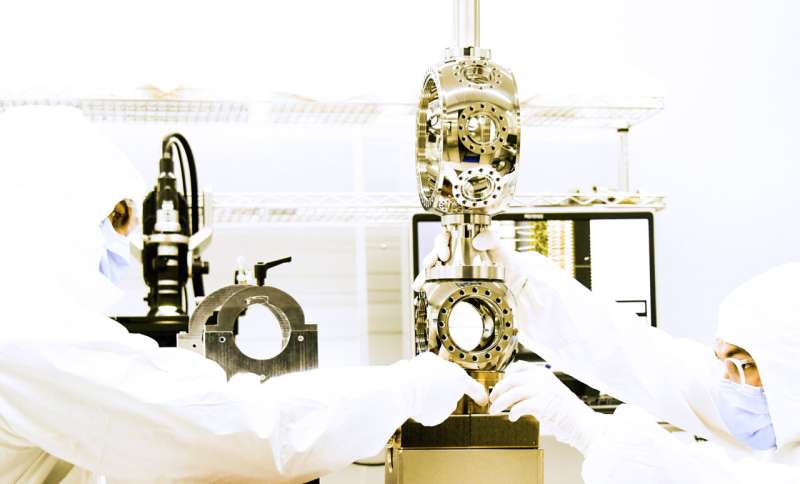
News
October 19, 2025
Simplified Sachdev-Ye-Kitaev model simulated on trapped-ion quantum computer
The simulation of strongly interacting many-body systems is a key objective of quantum physics research, as it can help to test the predictions of physics theories and yield new valuable insight. Researchers at Quantinuum, a quantum computing company, recently simulated a simplified version of a well-known theoretical model, the so-called Sachdev-Ye-Kitaev (SYK) model, using a trapped-ion quantum computer and a previously introduced randomized quantum algorithm.
**Quantum Leap: Trapped Ions Tackle Complex Physics Problem**
Scientists are pushing the boundaries of quantum computing, and a recent breakthrough at Quantinuum provides a tantalizing glimpse into the future of scientific discovery. Researchers have successfully simulated a simplified version of the Sachdev-Ye-Kitaev (SYK) model, a complex theoretical framework in physics, using a trapped-ion quantum computer. This achievement marks a significant step forward in the quest to understand strongly interacting many-body systems, which are notoriously difficult to analyze using classical computers.
The SYK model, while highly abstract, provides a crucial testing ground for theories related to quantum gravity and black hole physics. It describes a system where many particles interact strongly with each other, creating a complex web of relationships that are virtually impossible to untangle with traditional computational methods. The model's solutions can offer valuable insights into the behavior of materials and phenomena that are governed by quantum mechanics at their most fundamental level.
Simulating such a system is a major goal in quantum physics research. By creating a controllable quantum environment, scientists can test the predictions of theoretical models like the SYK and potentially uncover new physics that would otherwise remain hidden. This capability is particularly valuable because it allows researchers to explore scenarios that are beyond the reach of current experimental capabilities.
Quantinuum’s team employed a trapped-ion quantum computer, a type of quantum computer that uses individual ions (electrically charged atoms) held in place by electromagnetic fields to represent quantum bits, or qubits. These qubits are then manipulated using lasers to perform calculations. The researchers also utilized a randomized quantum algorithm, a sophisticated approach that harnesses the power of randomness to efficiently explore the vast computational space required to simulate the SYK model.
The successful simulation of the simplified SYK model demonstrates the potential of quantum computers to tackle challenging problems in fundamental physics. While this is an early step, it paves the way for more complex simulations in the future, potentially leading to breakthroughs in our understanding of the universe and the development of new technologies. This work underscores the growing importance of quantum computing as a powerful tool for scientific discovery, promising a future where complex scientific questions can be answered through the power of quantum simulation.
Scientists are pushing the boundaries of quantum computing, and a recent breakthrough at Quantinuum provides a tantalizing glimpse into the future of scientific discovery. Researchers have successfully simulated a simplified version of the Sachdev-Ye-Kitaev (SYK) model, a complex theoretical framework in physics, using a trapped-ion quantum computer. This achievement marks a significant step forward in the quest to understand strongly interacting many-body systems, which are notoriously difficult to analyze using classical computers.
The SYK model, while highly abstract, provides a crucial testing ground for theories related to quantum gravity and black hole physics. It describes a system where many particles interact strongly with each other, creating a complex web of relationships that are virtually impossible to untangle with traditional computational methods. The model's solutions can offer valuable insights into the behavior of materials and phenomena that are governed by quantum mechanics at their most fundamental level.
Simulating such a system is a major goal in quantum physics research. By creating a controllable quantum environment, scientists can test the predictions of theoretical models like the SYK and potentially uncover new physics that would otherwise remain hidden. This capability is particularly valuable because it allows researchers to explore scenarios that are beyond the reach of current experimental capabilities.
Quantinuum’s team employed a trapped-ion quantum computer, a type of quantum computer that uses individual ions (electrically charged atoms) held in place by electromagnetic fields to represent quantum bits, or qubits. These qubits are then manipulated using lasers to perform calculations. The researchers also utilized a randomized quantum algorithm, a sophisticated approach that harnesses the power of randomness to efficiently explore the vast computational space required to simulate the SYK model.
The successful simulation of the simplified SYK model demonstrates the potential of quantum computers to tackle challenging problems in fundamental physics. While this is an early step, it paves the way for more complex simulations in the future, potentially leading to breakthroughs in our understanding of the universe and the development of new technologies. This work underscores the growing importance of quantum computing as a powerful tool for scientific discovery, promising a future where complex scientific questions can be answered through the power of quantum simulation.
Category:
Technology